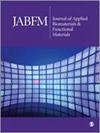Temperature-dependent Photoluminescence Properties of Eu2+-doped CaMgSi2O6 Phosphors
IF 3.1
4区 医学
Q2 BIOPHYSICS
Journal of Applied Biomaterials & Functional Materials
Pub Date : 2022-09-30
DOI:10.35745/afm2022v02.03.0004
引用次数: 1
Abstract
The solid-state reaction method was used to synthesize 0.025Eu2+-doped CaMgSi2O6 (Eu-CaMgSi2O6) powder in the reduction atmosphere of 5% H2 + 95% N2 at 1300oC with a duration of 4 h. The reduction atmosphere was removed when the temperature was down to 800oC. The XRD pattern showed that only the CaMgSi2O6 phase was observed in synthesized 0.025Eu2+-doped CaMgSi2O6 powder. Room-temperature photoluminescence excitation (PLE) and photoluminescence (PL) spectra of Eu-CaMgSi2O6 phosphors were recorded by using the Hitachi F-4500 fluorescence spectrophotometer at wavelength ranges of 200–430 and 350–600 nm, respectively. A new important finding is that the synthesized Eu-CaMgSi2O6 phosphor has three important PLE wavelengths. Therefore, Eu-CaMgSi2O6 phosphors are measured from 25oC (room temperature) to 200oC under three different PLE wavelengths to find the effect of temperature on the variations of maximum photoluminescence intensities (PLmax). All the PL spectra show that only one emission band with a central wavelength of 449 nm is found, which is independent of the PLE wavelengths and is caused by the transition of 4f7 → 4f65d1. Another important finding is that the different PLE wavelengths have an apparent effect on the PLmax value of the Eu-CaMgSi2O6 phosphor. Finally, the decay-time curves of Eu-CaMgSi2O6 phosphor under three PLE wavelengths are also investigated.Eu2+掺杂CaMgSi2O6荧光粉的温度依赖性光致发光特性
采用固相反应法,在5% H2 + 95% N2还原气氛下,在1300℃下合成0.025Eu2+掺杂CaMgSi2O6 (Eu-CaMgSi2O6)粉体,反应时间为4 h,温度降至800℃时去除还原气氛。XRD谱图表明,合成的0.025Eu2+掺杂CaMgSi2O6粉体中只存在CaMgSi2O6相。利用日立F-4500荧光分光光度计分别记录了Eu-CaMgSi2O6荧光粉在200 ~ 430 nm和350 ~ 600 nm波长范围内的室温光致发光激发(PLE)和光致发光(PL)光谱。一个新的重要发现是,合成的Eu-CaMgSi2O6荧光粉具有三个重要的PLE波长。因此,在25℃(室温)至200℃范围内,在三种不同的PLE波长下测量Eu-CaMgSi2O6荧光粉,以寻找温度对最大光致发光强度(PLmax)变化的影响。所有的PL光谱都表明,只有一个中心波长为449 nm的发射波段与PLE波长无关,是由4f7→4f65d1跃迁引起的。另一个重要的发现是,不同的PLE波长对Eu-CaMgSi2O6荧光粉的PLmax值有明显的影响。最后,研究了铕- camgsi2o6荧光粉在三个PLE波长下的衰减时间曲线。
本文章由计算机程序翻译,如有差异,请以英文原文为准。
求助全文
约1分钟内获得全文
求助全文
来源期刊

Journal of Applied Biomaterials & Functional Materials
BIOPHYSICS-ENGINEERING, BIOMEDICAL
CiteScore
4.40
自引率
4.00%
发文量
36
审稿时长
>12 weeks
期刊介绍:
The Journal of Applied Biomaterials & Functional Materials (JABFM) is an open access, peer-reviewed, international journal considering the publication of original contributions, reviews and editorials dealing with clinical and laboratory investigations in the fast growing field of biomaterial sciences and functional materials.
The areas covered by the journal will include:
• Biomaterials / Materials for biomedical applications
• Functional materials
• Hybrid and composite materials
• Soft materials
• Hydrogels
• Nanomaterials
• Gene delivery
• Nonodevices
• Metamaterials
• Active coatings
• Surface functionalization
• Tissue engineering
• Cell delivery/cell encapsulation systems
• 3D printing materials
• Material characterization
• Biomechanics
 求助内容:
求助内容: 应助结果提醒方式:
应助结果提醒方式:


